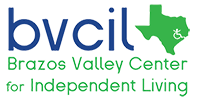Look for the Accessibility Help Desk near the shuttle drop off location. Below is a list of what you will find at the help desk. This is a community service brought to you by the Brazos Valley Center for Independent Living. Please stop by and say howdy!
- Information about:
- Accessible parking;
- Transportation options;
- Restrooms;
- Exit routes;
- Accessible routes; and
- Where to find gluten free food options.
- Materials in alternate formats:
- Tactile maps; and
- Braille schedules.
- Concierge services/items including:
- Long bendable straws;
- Wheelchair charging station;
- Loaner wheelchair;
- Service animal relief area;
- Transportation; and
- Designated driver services.
- On-site services:
- Sighted-guides;
- Sign Language Interpreting; and
- Personal Attendants.
The BVCIL is a consumer-based, consumer-controlled, cross-disability, cross-cultural, non-residential, private nonprofit 501(c)(3) corporation. BVCIL’s mission is to promote the full inclusion and participation of individuals with disabilities in all aspects of community life.













